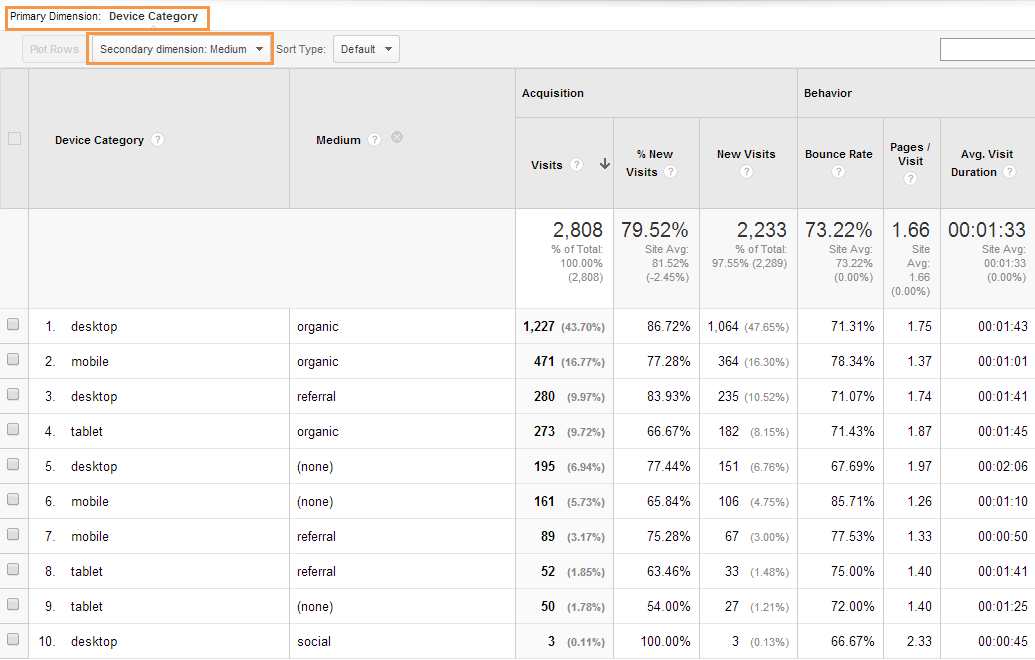Mastering Secondary Dimension in Google Analytics: A Total Overview
Mastering Secondary Dimension in Google Analytics: A Total Overview
Blog Article
Make The Most Of Coverage Precision With Second Dimension in Google Analytics
Recognizing exactly how to optimize reporting accuracy with second dimensions in Google Analytics can substantially boost the depth of understandings derived from data analysis. By integrating additional dimensions tactically, marketing experts can uncover concealed patterns and correlations that might not be promptly evident when examining main metrics alone.
Understanding Additional Dimensions in Google Analytics
To boost information evaluation and gain much deeper insights right into individual behavior, recognizing second dimensions in Google Analytics is vital. Second dimensions enable individuals to sector and better explore information past the key measurement picked. By including second dimensions, analysts can fine-tune their reports to expose even more detailed details regarding customer interactions on a website. While the main dimension might show the total number of page sights, including a second dimension such as 'source/medium' can offer insights right into where the web traffic originated from. This additional layer of details enables marketers to examine the efficiency of different marketing campaigns or networks in driving website traffic to the internet site.
In addition, understanding additional measurements is vital for creating more customized reports customized to specific business objectives. By selecting the appropriate combination of primary and additional measurements, experts can reveal patterns, patterns, and correlations that may otherwise remain covert. This nuanced method to data evaluation encourages businesses to make educated choices based on an extensive understanding of user actions across different dimensions.

Just How to Apply Secondary Measurements
When leveraging secondary measurements in Google Analytics, the sensible application includes selecting specific information parameters to more refine understandings past the key measurement's range. To use secondary dimensions effectively, begin by accessing the report or dataset where you wish to delve deeper right into the information. Remember that additional dimensions help offer context and granularity to your primary dimension data, allowing you to extract even more significant and actionable insights from your Google Analytics reports.
Leveraging Secondary Measurements for Insights
Making use of secondary dimensions in Google Analytics allows for a more extensive analysis of data, providing valuable understandings beyond the main measurement's scope. By leveraging second dimensions, individuals can delve much deeper into the performance metrics of their site or app, uncovering hidden patterns and trends that might not be right away apparent when only taking a look at primary measurements.
One trick advantage of making use of second dimensions is the capability to segment and filter data extra precisely. This can help marketing professionals and analysts much better understand the behavior of certain individual sections, such as brand-new site visitors versus returning site visitors, or web traffic coming from various geographical locations.
In addition, second measurements allow individuals to compare and comparison numerous information points within the exact same record, providing a more holistic view of performance (Secondary Dimension in Google Analytics). As an example, combining the primary measurement of landing pages with additional measurements like demographics or tools can disclose which web pages are most reliable in engaging individuals on different tools or from different demographic teams.
In essence, leveraging second measurements in Google Analytics equips customers to remove richer insights from their data, leading to more informed decision-making and inevitably, enhanced efficiency.
Finest Practices for Secondary Measurements
When analyzing information in Google Analytics, including second measurements successfully enhances the deepness of insights stemmed from the primary metrics. To make one of the most out of second dimensions, it is vital to stick to best practices that make certain significant and exact reporting. It is crucial to choose secondary dimensions that line up with the key statistics you are examining. Picking pertinent second dimensions helps in providing context and a clearer understanding of the information being examined.
In addition, it is advised to limit the variety of second measurements used in a solitary record to prevent overwhelming the evaluation see it here with way too much information. Concentrating on a couple of essential additional measurements each time can result in even more focused and actionable insights. Furthermore, think about try out different mixes of main and additional dimensions to uncover distinct fads and patterns that may not be obvious when taking a look at the data alone.
Advanced Analysis Techniques With Additional Measurements
Exploring intricate information relationships with the calculated application of additional measurements can unveil nuanced understandings that elevate the deepness of analysis in Google Analytics. By incorporating second dimensions with main data sets, sophisticated analysis strategies can be used to draw out valuable details.
In addition, second measurements can enhance the evaluation of conversion courses by providing additional Learn More Here context. Recognizing the numerous touchpoints an individual connects with before converting can be crucial in enhancing the consumer trip - Secondary Dimension in Google Analytics. By utilizing secondary measurements to explore specifics such as website traffic sources or tools used, marketers can tailor strategies to target high-converting networks efficiently
Final Thought

To boost data analysis and gain deeper insights right into individual behavior, understanding secondary measurements in Google Analytics is essential - Secondary Dimension in Google Analytics. Secondary dimensions enable users to segment and better dissect data beyond the main measurement chosen. While the primary measurement may show the complete number of page views, adding a second measurement such as 'source/medium' can provide understandings into where the web traffic stemmed from.When leveraging second dimensions in Google Analytics, the sensible application entails picking certain information specifications to further fine-tune understandings past the key measurement's extent. Remember that additional dimensions aid offer context and granularity visit the site to your key dimension data, enabling you to extract even more actionable and significant insights from your Google Analytics records
Report this page